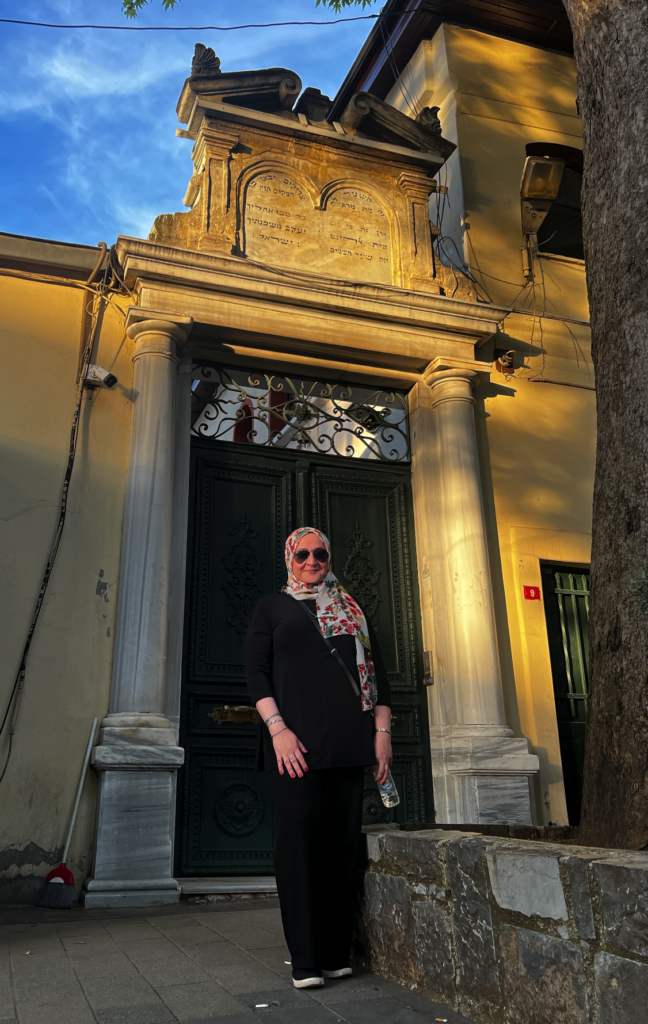It was a pleasant Saturday evening as my Turkish friend Aslihan and I made our way through the tight historic streets of the Asian side of Istanbul. I was adamant about visiting a church and a synagogue since Turkey has such a rich history of being influenced by many different religions, traditions, and empires.
A kind individual pointed us to a synagogue on the corner of a nearby street. I wouldn’t have noticed because many properties in Istanbul are guarded by a high steel gate which doesn’t look any different from the rest of the properties on the street. It was obvious that these places of worship and little shops are homed in structures which are hundreds of years old.
 We knocked on the gate and rang the bell but no one was inside. A man passing by asked us what we wanted and then pointed us to a coffee shop a few feet away. There we found Kaihan, the coffee shop owner who happens to be Jewish and Turkish. Aslihan went on to explain to him in Turkish about our work at MFNN. Kaihan, an officer of the synagogue for the past 37 years, seemed a bit more at ease after he found out that I work with the Jewish community in the U.S and agreed to talk to us.
We knocked on the gate and rang the bell but no one was inside. A man passing by asked us what we wanted and then pointed us to a coffee shop a few feet away. There we found Kaihan, the coffee shop owner who happens to be Jewish and Turkish. Aslihan went on to explain to him in Turkish about our work at MFNN. Kaihan, an officer of the synagogue for the past 37 years, seemed a bit more at ease after he found out that I work with the Jewish community in the U.S and agreed to talk to us.
We sat on stools by a small table outside of his coffee shop. The people around us were visibly curious about what we were doing there The community was mostly Jewish and Aslihan and I were visibly Muslim. He offered us coffee/tea and with a great big smile, invited us to sit down.
He began to tell us about himself, capturing our attention for the better part of an hour. He about the history of the Turkish Jewish community. He started with the Spanish Inquisition of 1478, and shared about the Jewish community in Spain being protected by the Muslim leadership who controlled that area. He also shared about how things changed once the Spanish Inquisition took place and how many Muslims and Jewish people were forced out of Spain. One of the only places they felt safe living was under the Ottoman Empire in Turkey. The Ottoman Empire was ruled by Muslims until the early 1900’s, when it collapsed.
Kaihan mentioned the historic Jewish cemetery they have in the area, which gets hundreds of local and international visitors every year. He shared about the leaders who are buried there who have done great work to establish the Jewish community. The cemetery is symbolic of the various Jewish struggles, following the Spanish Inquisition.
I asked him about the synagogue and how it is managed internally. I was curious about how it was financed as well. Kaihan told me that the Jewish community pays for the operations of the synagogue and the Turkish government also has programs for places of worship as well. The Turkish government pays for their electricity bill and they are not charged a water bill. In the 1800’s, the Turkish government approved a request for the synagogue to be renovated.
Kaihan was most gracious with his time and wisdom. He told me to come back again so that he can show me the synagogue from the inside. He was happy to know that MFNN are doing this work and mentioned how important it is for this work to come from the United States. I am looking forward to returning to Turkey and learning more about its religious minority communities. There is so much for us to listen, understand and emulate from history!